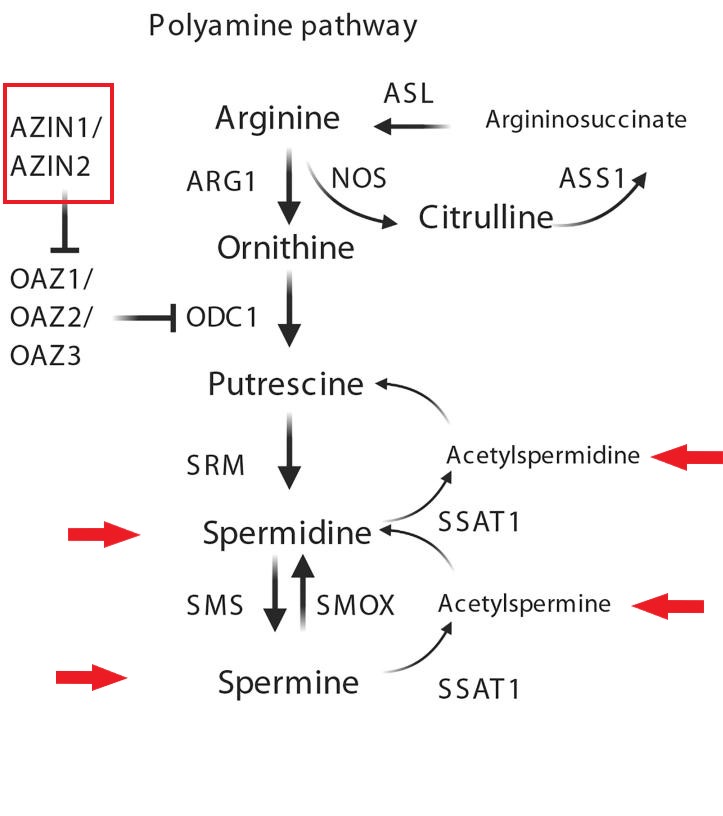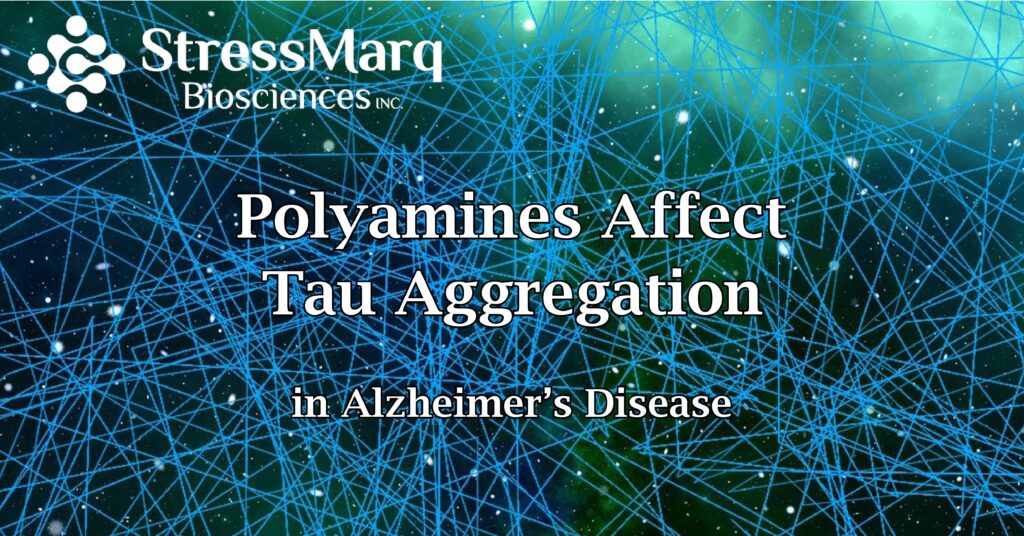How Polyamines Affect Tau Aggregation in Alzheimer’s Disease
Tauopathies are diseases associated with abnormal aggregation of tau proteins in neurons4,5. A common example of this is Alzheimer’s Disease (AD), characterized by the accumulation of hyperphosphorylated and insoluble filaments made up of these tau monomers5. Many researchers look into molecular pathways of the brain in order to uncover information about the cause of tau aggregation in neurological diseases. One goal of this is to identify potential biomarkers or targets for treatments. Molecules involved in the pathway for tauopathy in neurodegenerative diseases are still being investigated.
In this study, researchers at the University of South Florida propose the polyamine stress response as a potential target for tauopathies. Here, they show that neurons in AD brains display altered expression of polyamine stress response (PSR) proteins, and suggests a link to tauopathy.
StressMarq’s selection of tau proteins can be used to help researchers further our understanding of tauopathies. In this recent publication, StressMarq’s human recombinant Tau441 (P301S) Preformed Fibrils were used to observe the effect of polyamines and acetylpolyamines on tau aggregation and seeding.
What are Polyamines?
Polyamines are naturally occurring molecules that are necessary for cell division and growth in living organisms1. In the brain, they play a role in physiological neuron functioning, and normal cognitive function2,4. Since polyamines have a key role in neurotransmission and in affecting higher brain functions, dysregulation can impact cognitive functioning4.
What is Polyamine Stress Response?
Physical and emotional stimuli can induce a polyamine stress response (PSR)4. This is a natural and adaptive response to stimuli which disrupts physiological polyamine homeostasis1,4.
Although short term PSR is beneficial, chronic PSR can lead to maladaptive accumulation of polyamines in the brain3,4. Normally, the PSR is self-regulated and recycles polyamines by acetylation, where acetylated products convert back to precursors3,4. The function of acetylpolyamines remain unclear3,4. However, in the case of tauopathies, altered expression in PSR genes leads to polyamine dysregulation3. In this study, Sandusky-Beltran et. al show that spermine and acetylspermine presence in neurons elicit opposite effects on tau neuropathology.

Polyamine pathway. Antizyme inhibitor2 (AZIN2) is associated with positive regulation of polyamine biosynthesis. Taken from Sandusky-Beltran et al.
Alzheimer’s Brains Reveal Altered Polyamine Gene and Protein Levels
Using qRT-PCR, polyamine signaling gene expression were compared with healthy and AD brains. Transcripts for polyamine metabolism increased, most notably AZIN2. As well, protein levels for tau and AZIN2 were detected. The result of increased expression of AZIN2 is the increase of polyamine presence in neurons of AD brains. These findings suggest a role of polyamines in tauopathy.
Tau Aggregation Affected by Acetylation of Polyamines
StressMarq’s Tau441 (P301S) PFFs were used to compare effects of polyamines and acetylpolyamines on tauopathy. Results from split GFP oligomerization and FRET show that spermidine presence decreased tau aggregation, while acetylspermidine increased tau aggregation.
Shown in the fluorescence image below, lower fluorescence appears in the biosensor cells treated with spermidine (300nM ) + tau (10nM) treatment compared to the control (top right vs far left). Conversely, higher fluorescence is detected with acetylspermidine (300nM) + tau (10nM) treatment compared to the control (bottom right vs. far left). Statistical analysis was used to quantify percentage of fluorescence seen below.

Polyamine decrease tau seeding, and acetylpolyamines increase tau seeding. Percentage of fluorescence from FRET biosensor cells show a significant difference between treatment with spermidine (300nM) + tau (10nM) and acetylspermidine (300nM) + tau (10nM); top right vs. bottom right. Taken from Sandusky-Beltran et al.
Polyamine Dysregulation Occurs in Alzheimer’s Disease
To develop a deeper understanding of polyamine dysregulation in tauopathy, researchers investigated effect of polyamines on tau aggregation in mice brains. Polyamines (spermidine and spermine) were shown to have the largest effect on reducing tau fibrilization. For the short term, this can be beneficial for stabilizing tau during a PSR. However, chronic PSR may advance disease progression by accumulation of acetylated polyamines in the brain. This was seen by acetyl-polyamines promoting tau fibrilization3.
Past studies suggest that mild polyamine dysregulation is detectable in AD patients, and proposed that the polyamine pathway products (such as acetylspermine and spermine) could function as biomarkers for tauopathies in patients3. Thus, detecting the disease earlier than conventional clinical diagnosis.
References
- Gilad, G. M., & Gilad, V. H. (2003). Overview of the brain polyamine-stress-response: Regulation, development, and modulation by lithium and role in cell survival. Cellular and Molecular Neurobiology, 23(4), 637-649.
- Hiasa, M., Miyaji, T., Haruna, Y., Takeuchi, T., Harada, Y., Moriyama, S., Yamamoto, A., Omote, H., & Moriyama, Y. (2014). Identification of a mammalian vesicular polyamine transporter. Scientific reports, 4, 6836. https://doi.org/10.1038/srep06836.
- Sandusky-Beltran, L. A., Kovalenko, A., Placides, D. S., Ratnasamy, K., Ma, C., Hunt, J., Jerry B, Liang, H., Calahatian, J. I. T., Michalski, C., Fahnestock, M., Blair, L. J., Darling, A. L., Baker, J. D., Fontaine, S. N., Dickey, C. A., Gamsby, J. J., Nash, K. R., Abner, E., Selenica, M. B., & Lee, D. C. (2021). Aberrant AZIN2 and polyamine metabolism precipitates tau neuropathology. The Journal of Clinical Investigation, 131(4)https://doi.org/10.1172/JCI126299.
- Sandusky-Beltran L.A., Kovalenko, A., Ma, C., Calahatian, J.I.T., Placides, D.S., Watler, M.D., Hunt, J.B., Darling, A.L., Baker, J.D., Blair, L.J., Martin, M.D., Fontaine, S.N., Dickey, C.A., Lussier, A.L., Weeber, E.J., Selenica, M.B., Nash, K.R., Gordon, M.N., Morgan, D., Lee, D.C.. Spermidine/spermine-N1-acetyltransferase ablation impacts tauopathy-induced polyamine stress response. Alzheimers Res Ther. 2019 Jun 29;11(1):58. doi: 10.1186/s13195-019-0507-y. PMID: 31253191; PMCID: PMC6599347.
- Spillantini, M.G. & Goedert, M. Tau pathology and neurodegeneration. Lancet Neurol. 2013 Jun;12(6):609-22. doi: 10.1016/S1474-4422(13)70090-5. PMID: 23684085.


Leave a Reply